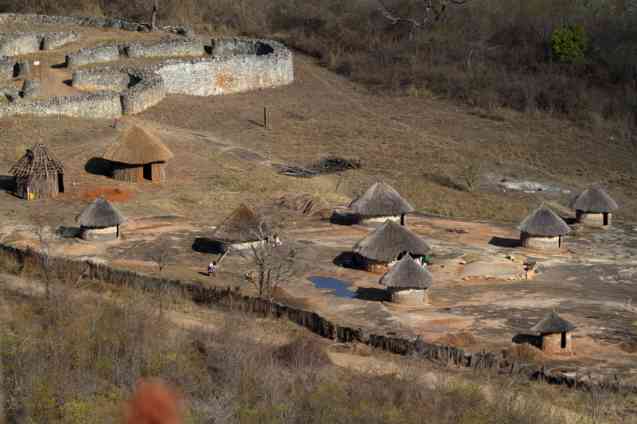The Best of African People & Culture: What are the Great Zimbabwe Ruins?
The Great Zimbabwe Ruins are an awe-inspiring cultural history destination. Their importance to the people of Zimbabwe is evident in the fact that the county’s name is taken from the name of the Great Zimbabwe Ruins; “Dzimba-dza-mabwe” is Zimbabwe’s Houses of Stone. The emblem featured on Zimbabwe’s national flag, is also based on an artefact found at the Great Zimbabwe Ruins, a soapstone carving of a seated bird.
First described for Europeans by Portuguese army captain, Vicente Pegado in 1531, the Great Zimbabwe Ruins have been shrouded in mystery. The colonial project actively sought to deny that such architectural wonders could be built by Africans, and British archaeologist James Theodore Bent, in 1881 threw away artefacts that were deemed ‘insignificant’ but would have proved that the ruins were of African origin. Bent declared that Africans were not capable of building such treasures.
 Stone work, Great Zimbabwe Ruins
Stone work, Great Zimbabwe Ruins
Sadly, during this period the Great Zimbabwe Ruins were stripped of gold, and other valuable artefacts, while pottery and Iron Age implements were destroyed. Today, the intricate masonry has stood the test of time, and the 11th-century ruins are popular with safari tours that visit Zimbabwe. So where are the Great Zimbabwe Ruins? Who built them? How were they constructed and why are they so important? This blog post explores everything you need to know about the Great Zimbabwe Ruins.
Where can you see the Great Zimbabwe Ruins, where are they located?
Located in southern Africa, the Great Zimbabwe Ruins, “Dzimba-dza-mabwe”, are located in southeastern Zimbabwe, about 30 km from the town of Masvingo. The Great Zimbabwe Ruins are 326 km / 203 miles and 4.5-hour drive south of Harare, and 309 km / 192 miles and just under a 4-hour drive east of Bulawayo.
Famous African Tribes: Who Built the Great Zimbabwe Ruins?
That the Great Zimbabwe Ruins were made by African people was denied for more than a century. Archaeologists and explorers attributed the ruins to Egyptians, Phoenicians, and Babylonians, the famous King Solomon, and the dwelling place of the Queen of Sheba. In fact, in 1905, archaeologist David Randall-MacIver was banned by Rhodesia’s colonial government for suggesting that the Zimbabwe Ruins were “unquestionably African in every detail.
There is much mystery that surrounds the Great Zimbabwe Ruins. The active efforts to deny the site's true genesis have sadly resulted in the loss of artefacts that could have helped to solve the puzzle of the ancient past. However, today it is believed that the Great Zimbabwe Ruins were built by descendants of modern Zimbabwe’s Shona people, who make up around 70% of the population. “Dzimba-dza-mabwe” is Shona and means houses of stones.
 Zimbabwe safari, Great Zimbabwe Ruins
Zimbabwe safari, Great Zimbabwe Ruins
Great Civilizations: When Were the Great Zimbabwe Ruins Built?
The Great Zimbabwe Ruins are thought to have been constructed from the 11th century to around the mid-14th century. At Great Zimbabwe’s peak, the kingdom was large and powerful, with a population of around 20,000 people, similar to the population of London at the same point in history. Based on archaeological evidence, the kingdom was built on trade with the main export being gold which was mined in the area. The Khami ruins, located just outside of Bulawayo, had developed after Great Zimbabwe’s decline but were also abandoned by the mid-16th century.
 Great Zimbabwe Ruins, Stone walls
Great Zimbabwe Ruins, Stone walls
Mega Mystery: How Were the Walls of Great Zimbabwe Constructed?
The Great Zimbabwe Ruins are spread over an extensive 800 hectares. The site can be separated into 3 distinct sections, the Hills Ruins, the Great Enclosure, and the Valley Ruins. The Hill Ruins were continuously inhabited from the 11th to the 16th century, the Great Enclosure was built around the 14th century, and the Valley Ruins date to the 19th century.
African Budget Safaris: Great Zimbabwe Tours |
|---|
The Great Enclosure is the most impressive structure, and the style and scale are unparalleled in southern Africa. At their base, the walls are 6m thick, the walls are 11m tall and they run almost 250 meters in length. It is the largest single structure in sub-Saharan Africa, and the second largest in Africa, beaten in size only by the wonders of the pyramids in Egypt.
The walls are made of granite blocks that have been stacked precisely. Importantly, the structure does not use mortar to hold them in place, making the scale even more remarkable. To quarry the granite bricks, the Great Zimbabwe stone masons, took advantage of natural weathering processes that shaped the stones into building material. The engineering of these walls was a major undertaking to these pre-colonial kingdoms, and together with artefacts found at the site, point to a sophisticated society.
 Great Zimbabwe Ruins, African people
Great Zimbabwe Ruins, African people
Why the Great Zimbabwe Ruins Matter? Africa’s Global Heritage
The very existence of the Zimbabwe Ruins was counter the colonial project of dominating and exploiting Africa. If the continent did not have significant culture or heritage, then colonial governments could claim the land. The Zimbabwe Ruins matter because they point to a historical connection to the world and thus Africa becomes historically and culturally important in its own right.
The importance of the Great Zimbabwe Ruins is that it did not exist in isolation, but rather was part of an extensive trade network that stretched from Africa to Europe, the Middle East, and China. In southern Africa, the Kingdom of Mapungubwe connected with Khami, Great Zimbabwe, and Manyikeni, and these in turn connected with the port cities of Kilwa and Rhapta, and further up the coast Zanzibar and Mombassa. These trade ports can be reliably dated through the Periplus of the Eritrean Sea, a 1st-century catalogue of the East African trading coast.
 Zimbabwe Ruins, Great Zimbabwe
Zimbabwe Ruins, Great Zimbabwe
Based on the ruins of these kingdoms, great wealth and status, as well as technologically advanced and socially complex civilizations existed in Africa. These kingdoms traded the wealth of the region, old, ivory, and rhino horn, for exotic commodities like beads, bracelets, and porcelain from China, Venice, India, and Arabia, all of which have been found in Great Zimbabwe. These connections made southern Africa a global player before Europeans discovered a sea route to the East. Zimbabwean author, poet, and heritage specialist, Cynthia Marangwanda says of the Great Zimbabwe Ruins:
"It was Africans who created this. And over a millennium later it's still standing. It's a testament to who we are."
 From Above Great Zimbabwe Ruins
From Above Great Zimbabwe Ruins
The Great Zimbabwe Ruins Today
Today, the Great Zimbabwe Ruins are still highly politicized and used as a symbol of Zimbabwean nationalism. The Ruins receive tourists from around the world who come to marvel at this feat of African ingenuity, and the site is regularly visited by Shona groups who come to pay homage to their ancestors. Until very recently, a traditional healer was needed to commune with the spirits who guard the Great Zimbabwe Ruins and ask for permission to enter.
 Great Zimbabwe Ruins, African culture
Great Zimbabwe Ruins, African culture
To plan an African safari that includes a visit to the Great Zimbabwe Ruins, browse our Zimbabwe Safari tours or get in touch with us and chat with one of our experienced African travel consultants.
If you liked this post, these trips cover similar ground…
- 15 Day Zambia & Zimbabwe Safari - Livingstone to Victoria Falls
- 21-Day African Safari to Namibia, Botswana & Zimbabwe (Lodge Safari)
- 6 Day Best of Zimbabwe Safari (Lodge Overland Tour)
- Kruger, Zimbabwe & Botswana Camping Safari (Small Group Tour)
- Botswana & Zimbabwe Classical Safari
- Botswana, Zimbabwe & Victoria Falls African Safari Adventure
- 16 Day Kruger, Zimbabwe & Botswana Budget Safari
- Victoria Falls & Hwange Lodge - Zimbabwe Safari






 On the outskirts of Marloth Nature Reserve, Andrew can be found walking and swimming in the beautiful Langeburg Mountains. He is passionate about animals, birds, reptiles, and plants and loves nothing more than an adventure in nature. An established artist with a master's in English literature, Andrew has traveled far and wide but South Africa still has his heart.
On the outskirts of Marloth Nature Reserve, Andrew can be found walking and swimming in the beautiful Langeburg Mountains. He is passionate about animals, birds, reptiles, and plants and loves nothing more than an adventure in nature. An established artist with a master's in English literature, Andrew has traveled far and wide but South Africa still has his heart.









